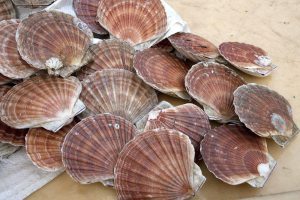One of the things we get asked a lot is “How did a dredge fishery get MSC certified?” It’s a reasonable question. Dredgers don’t have the best reputation with environmentalists and, in my heart, I count myself as an environmentalist and I think this certification is great news. So what gives Shetland the edge?
I’m often heard talking about Shetland’s strong history of spatial planning, closed areas, fishermen’s input, links to good science and the fact the they have a regulated fishery, all of which contribute to their achievement of MSC certification. While the achievement of MSC certification is down to a combination of a number of things this blog is a chance for me to go into a little more detail, to help explain a little more about what sets this fishery apart from some others.
A strong history of spatial planning and fishermen’s input
Shetland was part of a Scottish Government trial on Marine Spatial Planning which looked at all activities, habitats, features and interactions in Shetland’s marine area and mapped them all. The result is a really good understanding of what is out there and where everything happens which can then inform decisions on where certain activities – such as scallop dredging – should and shouldn’t be taking place. During the process Shetland fishermen worked with the pilot providing data and information and even voluntarily closed areas to fishing to protect sensitive marine habitats like horse mussel beds. The result was a culture of closed areas and fishermen’s involvement.
Links to good science
Shetland have good links to science through close working and collaboration with NAFC Marine Centre which has resulted in the availability of comprehensive data sets stretching back many years which were used to inform the MSC assessment. They also make for strong foundations for management decisions.
A regulated fishery
Probably key to pulling everything together – Shetland fisheries are controlled through a ‘Regulating Order’. This is a piece of law under the 1967 Seafisheries Act that means that they are able to control exactly who comes into the fishery and can control fishing effort, limit where people fish and even close a fishery if thought necessary. And what has brought all these together is partnership and collaboration in an Island community that understands the need for sustainability for future generations.
Detail, detail, detail…
One thing I find interesting is that when SSMO entered the dredge scallop fishery into assessment, they also entered their lobsters. A lot of people assumed that, as it is a small scale, shellfish fishery using creels (or pots) that it would get through the assessment relatively easily. But that was not to be. The lobster fishery failed to meet the MSC standard (on stock information) and was not certified, while at the same time the dredged scallop fishery was certified. For me, that was an important reminder that we can’t just look at one aspect of a fishery like gear type or scale and make an assumption. I think the beauty of the MSC programme is that it looks at every fishery individually and every fishery is assessed against the same, globally recognised standard where a fishery’s own merits and issues are examined.
Shetland fishermen still hope to gain MSC certification for their lobster fishery and are working on the issues that were flagged up in the assessment process. For me, and many others at MSC, this highlights one of MSC’s strengths, being a driver for change in an industry that has woken up to the need for a sustainable future.
Shetland has set a great example of best practice and is one of those leading the way in UK fisheries. In theory, there is no reason why other scallop dredge fisheries with similar controls, spatial management and protection of delicate areas shouldn’t follow in their footsteps.
That’s one of the best things about the Shetland dredge fishery getting certified. They’ve shown other scallop dredge fisheries what they’ll need to do in order to become a sustainable and well managed fishery and pass an MSC assessment. This may not be easy, they’ll likely have to make a number of changes and I certainly can’t promise that they will pass. But, if they follow the Shetland example, there is no reason that with some hard work other scallop dredgers shouldn’t, one day, be certified as sustainable.

